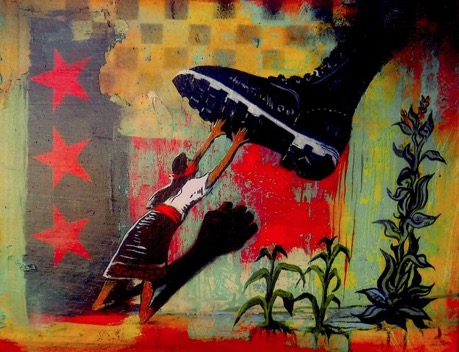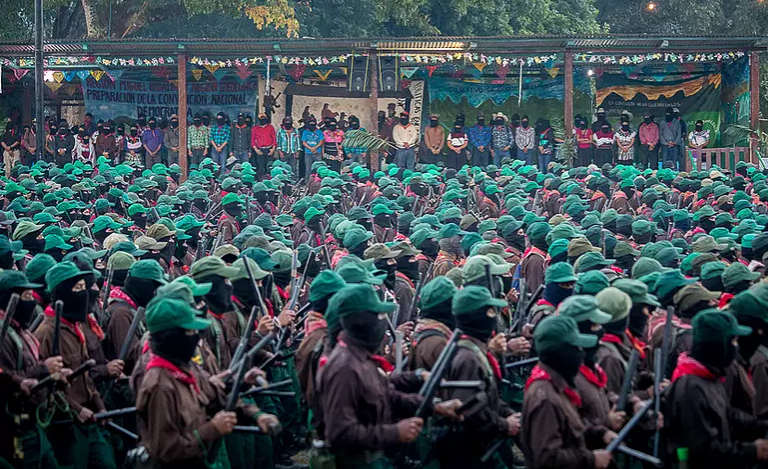by Luis Hernández Navarro
Image found on @ScotlandZapat
Photo (below): Francisco Lion

The armed uprising of the EZLN on January 1st, 1994 took the better part of the intellectual world by surprise. Enraptured by Salinas’ modernization, many analysts saw the indigenous uprising as an operation by “the old PRI dinosaurs” to derail the President’s reforms.
Ironically, 28 years after the insurrection, the nay-sayers of the Zapatista movement repeat the same argument but in the inverse. The insubordinates are, according to them, a perverse creation of the ex-president. They offer no proof whatsoever of their assertions. In the era of social networks they settle for offering memes. Interestingly enough, Carlos Salinas de Gortari and his project for the country were the most affected by the declaration of the rebel war and the taking of various Chiapan municipalities. From the first moment, they signalled that his government was illegitimate and demanded his removal.
Curiously, now that the rebels of Southeast Mexico are taking on a new political-military offensive, the arguments to disparage them are almost the same as those used almost three years ago. There is not much imagination in the new anti-rebel discourse. For that reason, it is worth remembering it, to see that, though it never explained anything, it seems to have no expiration date.
January 4th, 1994, in the El Día newspaper, journalist Raúl Trejo Delarbe, with close connections with the President Salinas’ communication team, concentrated on trying to discredit the indigenous nature of the uprising and its manipulation by non-indigenous persons. “The interviews with the press – he wrote – were offered by masked people, but who had perfect diction, in articulate Spanish. This is not about the indigenous, nor the poor…Those that are going to lose the most are the poor of Chiapas. Manipulated or used as a pretext, many of them are going to be victims of the military consequences of the insurrection. Who are those who have led the indigenous uprising to this situation?”
Saturday, the 8th of January of this same year, in Excelsior, writer Jaime Labastida, once a Sparticist1 friend for years of extraordinary Chiapanecan poets, who different from him, understood the nature of the conflict, went even further. He accused – based on pure speculation without foundation – international narco traffickers of organizing the armed uprising, disguising it as a “social conflict” in order to try to discredit the federal government internationally, to cause the stock market to crash, and to generate fear among foreign investors.
That same day, but in Reforma, Jaime Sánchez Susarray, one of the rising Salinista intellectuals in the world of the “analysts,” ventured that in the military operation there were “very dark groups that are manipulating the movement that could be looking for revenge to preserve their positions and perks” because “during this government, interests have been affected.”

Since the first moment of the insurrection, one of its most rabid critics and denigrators has been Héctor Aguilar Camín, head of one of the two hegemonic political-cultural blocks benefitted by Salinismo, that of Nexos magazine. Aguilar Camín relentlessly led the intellectual crusade against the uprising in several journalistic articles and interviews in the press and on television. In The Explosion of Chiapas, appearing in Proceso on January 10th, 1994 he accused the Zapatistas of being a summary of ideological and military delusion, which brings together a dangerous collection of debris: ideological fossils of the old and new left, religious people anchored in liberation theology, and the unemployed from the Central American war.”
Probably the most structured governmental perspective with regard to the origin of the nature of the armed movement is that of the anthropologist Arturo Warman, defender of Salinismo until the bitter end (“I serve the Executive branch,” he affirmed, “without ambiguity”), director of the National Indigenist Institute, agrarian attorney, Secretary of Agriculture and Agrarian Reform (https://bit.ly/2R7XcoE), and apologist for the agrarian counter-reform of Constitutional article 27.
In his work “Chiapas Today,” in La Jornada, January 16th, 1994, he explained the uprising not as an indigenous movement, but as a political-military project introduced among the indians, but without representing them.” And he added, “The poverty, exclusion and discrimination were a breeding ground for recruitment, but they are not the direct cause of the appearance of a political military movement that proposes total and prolonged war.”
The schematic provided ammunition to the official critics of the rebellion and served as the backbone — along with the report made by Alejandro Rubido for the Cisen2, recovering the testimony of a whistleblower — of the work of Carlos Tello and Alma Guillermo-Prieto.
Jorge Alcocer, once a militant of the Mexican Communist Party, later undersecretary of the Interior with the PRI, and now coordinator of advisors to Olga Sanchez Cordero in the Ministry of the Interior under the 4T, warned in Proceso on January 17, about the danger of granting the “EZLN the representation necessary to be recognized as a political-military organization with the right to negotiate, with the powers of the Union, the demands such as those raised in its communiqués.” To do so, he said, “would be to open a Pandora’s box.”
The list of writers who, from Salinas’ time, built the anti-Zapatista opinion matrix is, of course, much longer, and includes writers such as Jorge Castañeda, future Chancellor of the PAN government of Vicente Fox, whom the armed uprising sentenced to theoretical orphanhood, when his criticisms of the Latin American lefts were thwarted in practice.
It never stops being curious that today, many ideologues of the 4T mechanically repeat these theses about the EZLN, elaborated by the intellectuals of Salinasi-sm who, for the most part, are staunch critics of Obrador-ism. Certainly, other falsehoods such as, “they only appear during the elections,” or “they haven’t done anything in these years” or “they are a creation of Salinas de Gortari” emerged later. However, in part, they were narratively constructed by many of these publicists. Although it is only right to acknowledge that also participating in their elaboration, without the least respect for the truth, starting in 2001 (with the indigenous counter-reform) and in 2006 (with the launch of the Other Campaign), were the propagandists and politicians close to the then Party of the Democratic Revolution (PRD).
The beginning of the current Zapatista tour of Europe and the dispute over the indigenous narrative have once again set in motion the standard slander against the rebels. It would be very beneficial for the struggles over the transformation of the country, to have a serious and informed debate about the scope and the nature of the project of the indigenous people of the Mexican Southeast. However, in these times of polarization and of imposition of megaprojects, it seems nearly impossible for something like this to happen.
This article was published in CaminoAlAndar on the 28th of April, 2021. https://www.caminoalandar.org/post/en-torno-a-los-or%C3%ADgenes-de-la-narrativa-antizapatista-luis-hern%C3%A1ndez-navarro This English translation has been posted by Schools for Chiapas.
Footnotes
- A member of a Marxist revolutionary movement organized in Germany during WWI.
- Center for National Intelligence
